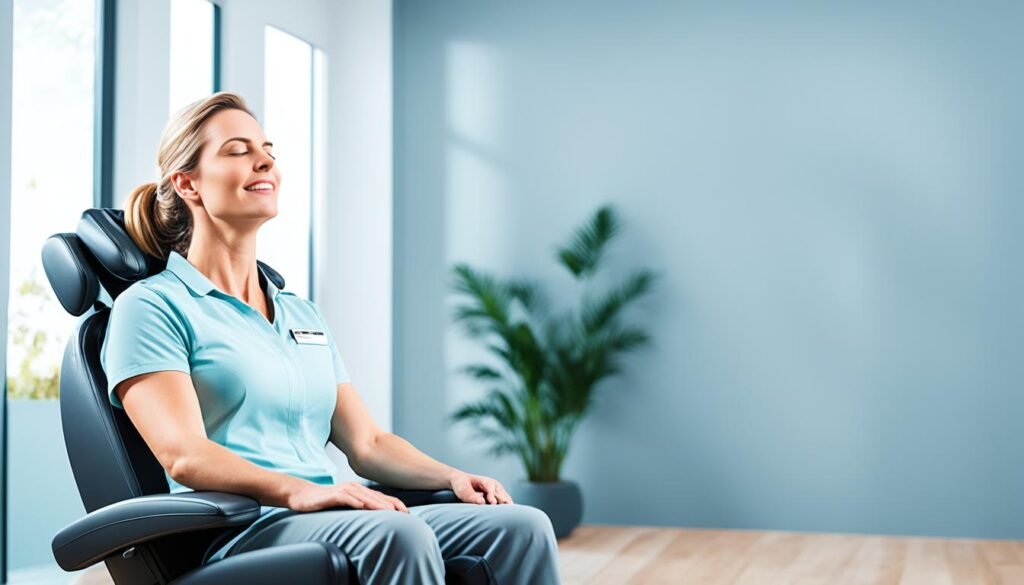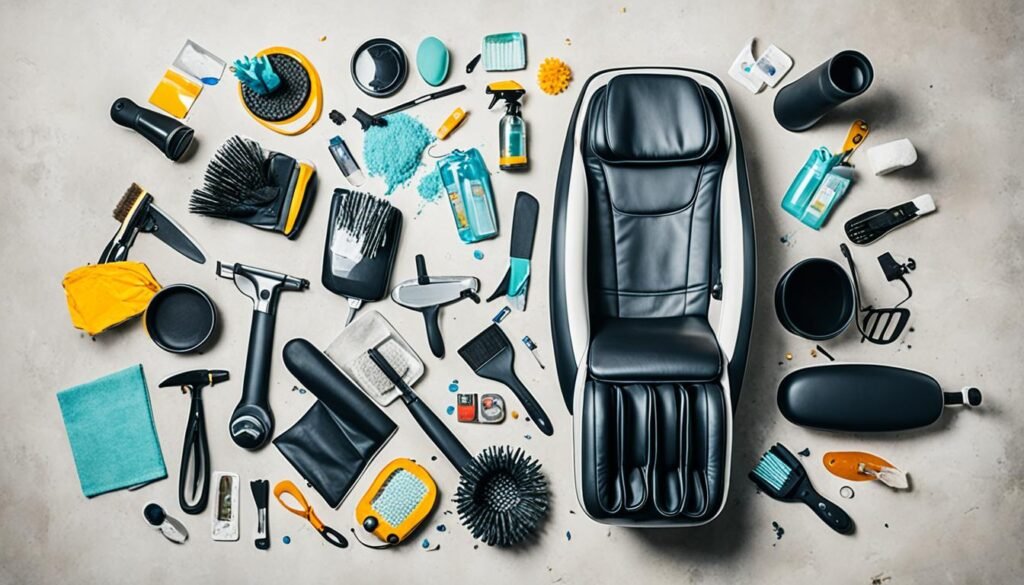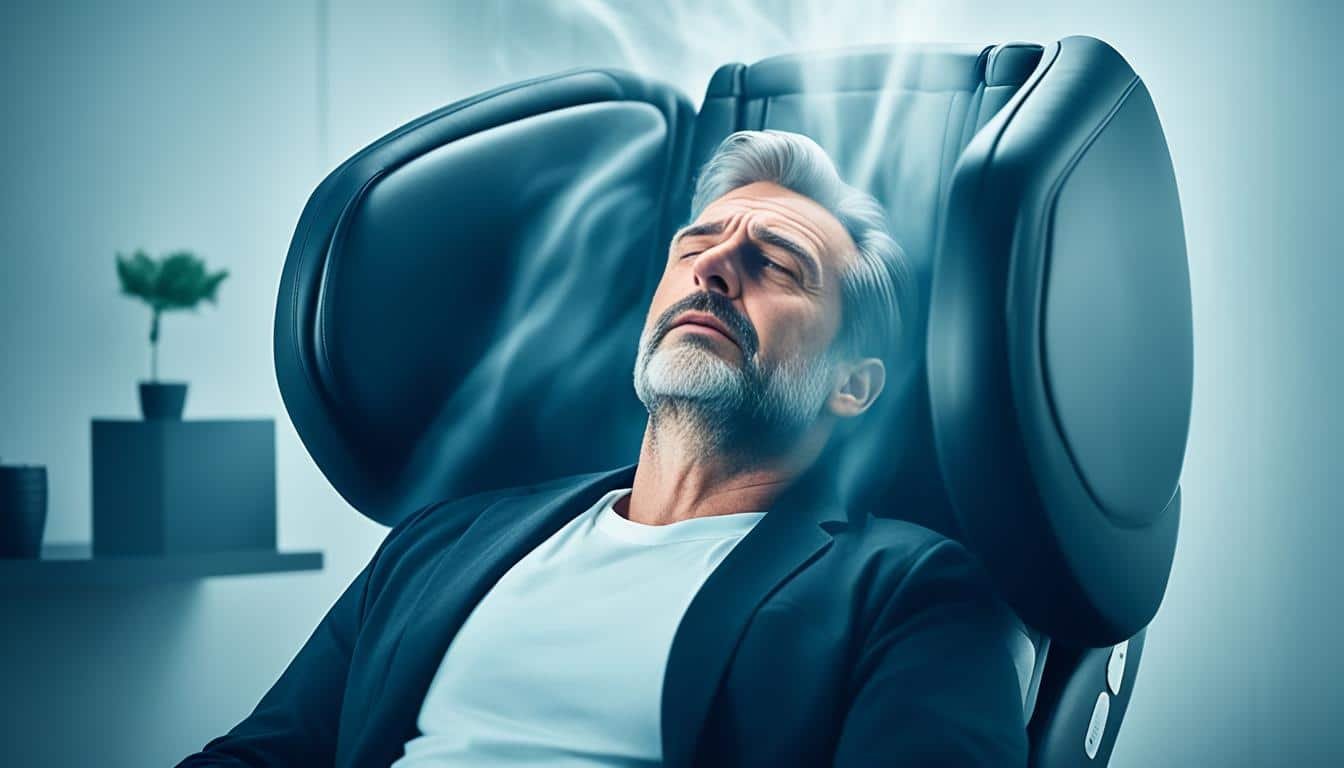Can you ever use a massage chair too much? These devices are great for relaxation, but knowing the limits of massage chair safety is key. This helps avoid side effects and health risks.
Using a massage chair too much can harm your muscles, cause inflammation, and lead to bruised tissues. It can also make existing injuries worse or cause new ones. To stay safe, follow the recommended massage chair usage limits.
This article will cover how long and how often to use a massage chair. We’ll talk about signs you might be using it too much and safe usage tips. By using your massage chair wisely, you can enjoy its benefits without the risks of massage chair overuse.
Key Takeaways
- Massage chairs offer physical and mental health benefits when used responsibly
- Overusing a massage chair can lead to muscle damage, inflammation, and bruising
- Ideal massage chair sessions should last between 2 to 15 minutes
- Listen to your body and stop using the massage chair if you experience discomfort or pain
- Choose a massage chair suitable for your needs and maintain it properly for optimal performance
Benefits of Regular Massage Chair Use
Using a massage chair regularly can greatly improve your health and happiness. It offers many benefits for both your body and mind. Modern massage chairs have advanced features and techniques that help you relax, reduce stress, and ease pain.
Physical Health Benefits
Massage chairs are great for easing muscle tension and pain. They target specific areas to give deep massages. This helps with back pain, neck stiffness, and sore muscles from exercise or daily activities.
They do more than just relieve pain. Regular use can improve blood flow, reduce inflammation, and make your muscles more flexible. This means you can move better and feel more comfortable.
Massage chairs also help with posture and spinal alignment. They have programs that focus on the spine. This can make your headaches go away, improve your breathing, and make your body more balanced.
Using a massage chair often can also boost your immune system. It helps with lymphatic drainage and removes toxins from your body.
Mental Health Benefits
Massage chairs are good for your mind too. They help reduce stress. The massage techniques relax your muscles, calm your mind, and lower stress hormones like cortisol.
This can make you feel more peaceful, happy, and overall well. Regular massages can also help you sleep better. They relax you and prepare your body for a good night’s sleep.
Good sleep is key for your mental health. It helps with your mood, thinking, and handling stress. Plus, massage chairs help with muscle tension that might keep you awake, so you sleep better and feel more refreshed.
| Benefit | Description |
|---|---|
| Pain Relief | Alleviates muscle tension and provides targeted relief for chronic pain |
| Improved Circulation | Enhances blood flow throughout the body, promoting healing and reducing inflammation |
| Stress Reduction | Calms the mind, reduces stress hormone levels, and promotes overall relaxation |
| Better Sleep | Relaxes the body and mind, leading to more restful and restorative sleep |
| Increased Energy | Boosts circulation and reduces fatigue, resulting in a natural energy boost |
Lastly, regular massage chair use can give you more energy. Improved circulation, less muscle tension, and less stress make you feel refreshed and ready for the day. This energy boost helps you be more productive, clear-minded, and enthusiastic about your tasks.
Recommended Frequency and Duration of Massage Chair Sessions
Understanding the right frequency and duration for massage chair sessions is key. These guidelines help you enjoy regular use safely. They also prevent overuse or injury. Let’s look at the best usage for both new and experienced users.
Ideal Usage for Beginners
If you’re new to massage chairs, start slow. Begin with 15-20 minute sessions, once or twice a week. As you get used to it, you can increase the time and how often you use it.
Beginners should start with gentle settings and slowly increase the pressure. This prevents discomfort or injury while still offering relaxation and health benefits.
Optimal Usage for Experienced Users
For regular users, you can use your massage chair more often and for longer. Aim for three to four times a week, with sessions lasting 30-60 minutes.
But don’t go over 60 minutes per session. Too much time can cause muscle fatigue or injury. Following these guidelines ensures you get the most benefits safely.
| Experience Level | Recommended Frequency | Recommended Duration |
|---|---|---|
| Beginner | 1-2 sessions per week | 15-20 minutes per session |
| Experienced User | 3-4 sessions per week | 30-60 minutes per session |
Follow these guidelines to use your massage chair safely and effectively. Always listen to your body and adjust as needed for your well-being.
Signs You May Be Overusing Your Massage Chair
Massage chairs are great for relaxation, but using them too much can be bad. Look out for these signs to know if you’re using it too much:
- Persistent muscle soreness or stiffness that lasts for hours or even days after a massage session
- Muscle cramps or spasms, particularly in areas where the massage chair focuses pressure
- Bruising or tenderness on the skin, especially in areas that receive deep tissue massage
- Fatigue or weakness in the muscles, which may indicate overworked tissues
- Decreased range of motion or flexibility due to muscle tightness or inflammation

If you see any of these signs, it’s time to take a break from your massage chair. Give your body a rest for 24 to 48 hours before going back. Use gentle stretches, drink plenty of water, and apply ice or heat to sore spots if it helps.
Listen to your body and respect its limits. Overusing a massage chair can lead to muscle injury and hinder your overall well-being.
To avoid using your massage chair too much, follow these tips:
| Frequency | Duration | Intensity |
|---|---|---|
| 2-3 times per week | 15-20 minutes per session | Low to moderate intensity |
Stick to these guidelines and listen to your body. This way, you can still enjoy your massage chair without risking muscle injury or other problems from overuse.
Potential Risks of Excessive Massage Chair Use
Massage chairs have many benefits, but there are risks from using them too much. Overusing your chair can cause muscle damage, inflammation, bruised tissues, and circulatory problems. It’s important to know your limits and listen to your body to avoid these issues.
Muscle Damage and Inflammation
One big risk is muscle damage and inflammation from using a massage chair too much. The intense pressure and vibrations can tear muscle fibers. This leads to inflammation, soreness, and pain, like after hard exercise. To avoid this, limit your chair use and give your body time to recover.
Bruised Tissues
Using a massage chair too much can also bruise soft tissues. The deep pressure can break tiny blood vessels under the skin, causing bruises. This is more likely if your skin is sensitive or you use the chair’s highest settings for a long time. If you get bruises, cut back on how often or how hard you use the chair.
Circulatory Issues
Using a massage chair too much can rarely cause blood clots and vein thrombosis. This is a big concern for people with circulatory problems or those who sit still for a long time. The constant pressure can make blood pool in the legs, increasing clot risk. To lower this risk, take breaks during long sessions, drink plenty of water, and talk to your doctor if you have circulatory issues.
If you have ongoing pain, discomfort, or strange symptoms after using your massage chair, stop using it and see a doctor. They can figure out if the chair is the problem and tell you how to use it safely.
Best Practices for Safe and Effective Massage Chair Use
To get the most from your massage chair, follow key safety tips and guidelines. These best practices ensure you enjoy massage therapy safely and effectively. They help you avoid overuse or injury.
Start by setting a timer for one hour per session. This prevents overuse and lets your body rest and recover. Keep track of how you feel before, during, and after each session. This helps you spot any signs of discomfort or overuse.

Target specific body areas in each session. This helps you focus on certain muscle groups without overworking others. By changing the areas you work on, you avoid overusing the chair and keep your massage routine balanced.
Remember, your massage chair is a powerful tool for relaxation and pain relief, but it’s crucial to use it responsibly and listen to your body’s signals.
Also, keep an eye on your chair’s performance. If it makes strange sounds or doesn’t respond, stop using it and call the manufacturer. Regular maintenance ensures your chair works well and provides safe massages.
- Always read and follow the manufacturer’s instructions for your specific massage chair model
- Adjust the intensity and settings to suit your comfort level and needs
- Stay hydrated before and after your massage sessions to support healthy circulation and tissue recovery
- Incorporate stretching and light exercise into your routine to complement the benefits of massage therapy
By following these best practices, you can enjoy massage therapy safely and effectively. Remember, your massage chair is a key tool for your health and well-being. Use it wisely and listen to your body’s needs.
Choosing the Right Massage Chair for Your Needs
When picking the best massage chair for daily use, think about what you need and like. Look for chairs with many massage types, adjustable strength, and custom programs for a personal touch.
Massage Chairs for Daily Use
For daily use, choose chairs made for regular sessions. They should be strong, use quality materials, and have the latest massage tech. Some top picks for daily use are:
- Synca CirC – Premium SL Track Heated Massage Chair
- Osaki OS-PRO First Class Massage Chair 3D
- Inada ROBO Massage Chair with Facial Recognition
Features to Consider
When looking for a massage chair for daily use, focus on these features for the best value:
- Massage techniques: Find chairs with various massage types like kneading, tapping, rolling, and shiatsu. This way, you can work on different muscle groups for a full massage.
- Adjustable intensity: Pick a chair you can adjust the strength of the massage. This lets you tailor it to what you can handle and what you prefer.
- Customizable programs: Choose chairs that come with set massage sessions and let you make your own. This way, you can match the massage to your specific needs.
- Heat therapy: Consider chairs with heat to help you relax more, improve blood flow, and ease muscle pain.
- Zero gravity positioning: Zero gravity chairs put your feet above your heart. This reduces spine pressure and helps you relax even more.
| Massage Chair | Key Features | Price Range |
|---|---|---|
| Synca CirC – Premium SL Track Heated Massage Chair | Gentle massages, heat therapy, zero gravity | $4,000 – $5,000 |
| Osaki OS-PRO First Class Massage Chair 3D | 23 automatic programs, adjustable intensity, body scanning | $7,000 – $8,000 |
| Inada ROBO Massage Chair with Facial Recognition | AI-powered recommendations, customizable programs, voice control | $10,000+ |
Think about these factors and what you need personally to find the best massage chair for daily use. It should give you the best relaxation, pain relief, and overall well-being.
Maintaining Your Massage Chair for Optimal Performance
To keep your massage chair working well, it’s important to take good care of it. Clean it regularly and fix any problems quickly. This will make your chair last longer and work better. Here are some tips to help you take care of your massage chair.
Regular Cleaning and Maintenance
It’s key to keep your massage chair clean for both health and longevity. The way you clean it depends on the upholstery material. For leather chairs, use a soft, damp cloth and then a leather conditioner to avoid cracks. For fabric chairs, vacuum often and clean stains with a gentle detergent. Always check your chair’s manual for the right cleaning steps.

Regular maintenance is also important to prevent problems and make your chair last longer. Some important tasks include:
- Tightening any loose bolts or screws
- Lubricating moving parts to prevent friction and wear
- Replacing worn-out padding or cushioning
- Checking electrical connections and wiring for damage
Troubleshooting Common Issues
Even with regular care, you might run into issues with your massage chair. Here are some common problems and how to fix them:
| Issue | Possible Cause | Solution |
|---|---|---|
| Chair not turning on | Power cord not plugged in or damaged | Check power cord connection and replace if damaged |
| Weak or no massage pressure | Loose connections or worn-out parts | Check connections and replace any worn-out parts |
| Unusual noises during operation | Loose or damaged components | Identify the source of the noise and tighten or replace parts as needed |
| Massage rollers not moving smoothly | Dirt or debris in the tracks | Clean the tracks and lubricate moving parts |
If you can’t fix a problem yourself, call the manufacturer or a professional repair service. Trying to fix it yourself could break your warranty and cause more damage.
Regular cleaning and maintenance, along with quick troubleshooting, will keep your massage chair working well for a long time.
Can You Overuse a Massage Chair?
Massage chairs are great for relaxing and easing muscle tension. But, overusing them can be risky. It’s key to know the limits and listen to your body to use them safely and effectively.
Understanding the Limits
Using a massage chair too much can happen if you do it too often or for too long. A good rule is to keep sessions short, around 15-20 minutes, and limit them to 3-4 times a week. Overdoing it can cause muscle soreness, bruising, or injury, which can undo the massage’s benefits.
- Start with shorter sessions and gradually increase the duration as your body adapts
- Allow your body sufficient time to rest and recover between sessions
- Adjust the intensity of the massage to suit your comfort level
- If you experience persistent discomfort or pain, discontinue use and consult a healthcare professional
Listening to Your Body
It’s important to be aware of your body when using a massage chair. This helps prevent overuse and ensures a good experience. Watch for signs that you might be using it too much, like:
| Symptom | Description |
|---|---|
| Persistent soreness | Lasting muscle soreness or stiffness that doesn’t improve with rest |
| Bruising | Visible bruises or tender spots on the skin after a massage session |
| Numbness or tingling | Prolonged numbness or tingling sensations in the massaged areas |
| Headaches | Onset of headaches or migraines following a massage session |
Remember, a massage chair is meant to make you feel better, not hurt. If you notice any of these signs, stop using it and let your body heal before you start again.
Knowing the limits and listening to your body helps keep your massage chair use safe, effective, and fun. Use it wisely and seek advice from a healthcare professional if you have concerns or health issues.
Conclusion
Massage chairs let you enjoy relaxation, stress relief, and pain management at home. By following best practices, you can safely enjoy these benefits. It’s important to use your chair wisely to avoid health issues.
Listen to your body and adjust the chair settings as needed. Regular care keeps your chair working well. Choose a chair that suits your needs and lifestyle.
Use your chair regularly but responsibly for better well-being. Enjoy the benefits while taking care of your body. This way, you can live a life free from pain and stress.
FAQ
What are the signs of overusing a massage chair?
How long should a massage chair session last?
What are the benefits of regular massage chair use?
How often should beginners use a massage chair?
What is the optimal usage for experienced massage chair users?
What are the potential risks of excessive massage chair use?
How can I ensure safe and effective use of my massage chair?
What should I consider when choosing a massage chair for daily use?
How can I maintain my massage chair for optimal performance?
What should I do if I experience persistent soreness or bruising after a massage session?
Source Links
- How Often Should You Use A Massage Chair? – https://titanchair.com/blogs/news/how-often-should-you-use-a-massage-chair
- How Often Can You Use a Massage Chair | Massage Chair Tips – https://www.massage-chair-relief.com/blog/how-often-can-you-use-a-massage-chair/
- Is it damaging to use a massage chair everyday? – https://www.massagechairheaven.com/blogs/blog/is-it-damaging-to-use-a-massage-chair-everyday













13 Comments
I get the health benefits, but isnt there a risk of chair addiction? I mean, its so easy to fall into the comfort trap and neglect real exercise. We need balance, dont we?
Indeed, but isnt the risk of a sofa addiction far greater? Balance is key, not fear.
Interesting article, but isnt there a risk of getting addicted to a massage chair? Like, could it replace human touch and interaction? Just a random thought. #massagetherapy #relaxationtips
Interesting read, but arent we promoting laziness here? I mean, why not just encourage regular exercise instead of depending on a massage chair? Lets get moving, folks!
Interesting read, but is there any chance were overlooking the potential dependency on massage chairs? Could this lead to mental health issues, like addiction, rather than alleviating them?
Interesting read, but arent there any possible side effects from daily overuse? Just curious, not everything thats good lacks downsides.
Does anyone feel theyre getting desensitized to the massage chair over time? Curious if the benefits diminish with overuse.
Is there a risk of becoming too reliant on massage chairs for relaxation, thereby neglecting other beneficial methods like meditation or yoga?
Interesting read, but arent there potential downsides to excessive massage chair use? Can it lead to muscle relaxation dependency? Just a thought.
Interesting article, but can overuse really lead to muscle damage? I thought more massage equals better relaxation and health.
Overuse doesnt equal better health, its about balance. Even water is harmful in excess!
Has anyone considered the environmental impact of these power-consuming massage chairs? Just a thought.
Interesting read! But wont excessive use of massage chairs make our bodies dependent on them for relaxation? Thoughts?